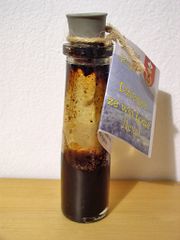Difference between revisions of "Pine tar"
Jump to navigation
Jump to search
| (2 intermediate revisions by the same user not shown) | |||
| Line 1: | Line 1: | ||
| − | [[File: | + | [[File:Wood_tar.jpg|thumb|Jar of pine tar]] |
== Description == | == Description == | ||
| − | A viscous brown to black liquid with a turpentine-like odor. Pine tar is obtained by the destructive distillation of pine wood, such as Pinus palustris. It contains [[phenol|phenols]], [[turpentine%20%28oil%29|turpentine]], [[rosin|rosin]], [[toluene|toluene]], [[xylene|xylene]], and other hydrocarbons. It is used in paints, roofing compositions, soaps and as an antiseptic. | + | A viscous brown to black liquid with a turpentine-like odor. Pine tar is obtained by the destructive distillation of pine wood, such as ''Pinus palustris''. It contains [[phenol|phenols]], [[turpentine%20%28oil%29|turpentine]], [[rosin|rosin]], [[toluene|toluene]], [[xylene|xylene]], and other hydrocarbons. It is used in paints, roofing compositions, soaps and as an antiseptic. Historically, it was used to weatherproof ropes on ships. Also in baseball, pine are is often applied to bat handles to improve the batter's' grip. |
| − | |||
== Synonyms and Related Terms == | == Synonyms and Related Terms == | ||
| − | goudron de pin (Fr.); alquitrán de pino (Esp.); wood tar; pine pitch; navy pitch; ship pitch | + | goudron de pin (Fr.); alquitrán de pino (Esp.); wood tar; pine pitch; navy pitch; ship pitch; pine tar oil |
| + | |||
| + | == Risks == | ||
| + | |||
| + | * Combustible. | ||
== Physical and Chemical Properties == | == Physical and Chemical Properties == | ||
| Line 13: | Line 16: | ||
* Soluble in ethanol, acetone, oils and sodium hydroxide solutions. | * Soluble in ethanol, acetone, oils and sodium hydroxide solutions. | ||
* Slightly soluble in water. | * Slightly soluble in water. | ||
| − | * Density = 1.03-1.07 | + | * Density = 1.03-1.07 g/ml |
| − | * Boiling Point = 240-400 | + | * Boiling Point = 240-400 C |
| − | |||
| − | |||
| − | |||
| − | |||
| − | |||
| − | |||
| − | |||
| − | |||
| − | |||
| − | |||
| − | |||
| − | == | + | ==Resources and Citations== |
* G.S.Brady, ''Materials Handbook'', McGraw-Hill Book Co., New York, 1971 Comment: p. 801 | * G.S.Brady, ''Materials Handbook'', McGraw-Hill Book Co., New York, 1971 Comment: p. 801 | ||
| Line 37: | Line 29: | ||
* ''The American Heritage Dictionary'' or ''Encarta'', via Microsoft Bookshelf 98, Microsoft Corp., 1998 | * ''The American Heritage Dictionary'' or ''Encarta'', via Microsoft Bookshelf 98, Microsoft Corp., 1998 | ||
| − | * Art and Architecture Thesaurus Online, | + | * Art and Architecture Thesaurus Online, https://www.getty.edu/research/tools/vocabulary/aat/, J. Paul Getty Trust, Los Angeles, 2000 |
[[Category:Materials database]] | [[Category:Materials database]] | ||
Latest revision as of 12:31, 8 September 2022
Description
A viscous brown to black liquid with a turpentine-like odor. Pine tar is obtained by the destructive distillation of pine wood, such as Pinus palustris. It contains phenols, turpentine, Rosin, Toluene, Xylene, and other hydrocarbons. It is used in paints, roofing compositions, soaps and as an antiseptic. Historically, it was used to weatherproof ropes on ships. Also in baseball, pine are is often applied to bat handles to improve the batter's' grip.
Synonyms and Related Terms
goudron de pin (Fr.); alquitrán de pino (Esp.); wood tar; pine pitch; navy pitch; ship pitch; pine tar oil
Risks
- Combustible.
Physical and Chemical Properties
- Soluble in ethanol, acetone, oils and sodium hydroxide solutions.
- Slightly soluble in water.
- Density = 1.03-1.07 g/ml
- Boiling Point = 240-400 C
Resources and Citations
- G.S.Brady, Materials Handbook, McGraw-Hill Book Co., New York, 1971 Comment: p. 801
- Richard S. Lewis, Hawley's Condensed Chemical Dictionary, Van Nostrand Reinhold, New York, 10th ed., 1993
- Random House, Webster's Encyclopedic Unabridged Dictionary of the English Language, Grammercy Book, New York, 1997
- The American Heritage Dictionary or Encarta, via Microsoft Bookshelf 98, Microsoft Corp., 1998
- Art and Architecture Thesaurus Online, https://www.getty.edu/research/tools/vocabulary/aat/, J. Paul Getty Trust, Los Angeles, 2000
